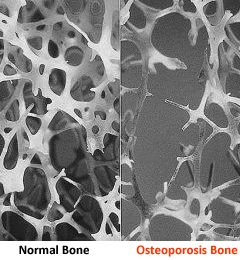
Frequently Asked Questions
What is Osteoporosis?
Osteoporosis, which literally means porous bone, is a disease in which the density and quality of bone are reduced. As bones become more porous and fragile, the risk of fracture is greatly increased. The loss of bone occurs silently and progressively. Often there are no symptoms until the first fracture occurs.
What causes osteoporosis?
 Our bones are living tissue and constantly changing. From the moment of birth until young adulthood, bones are developing and strengthening. Our bones are at their most dense in our early 20s – called peak bone mass
Our bones are living tissue and constantly changing. From the moment of birth until young adulthood, bones are developing and strengthening. Our bones are at their most dense in our early 20s – called peak bone mass
As we age some of our bone cells begin to dissolve bone matrix (resorption), while new bone cells deposit osteoid (formation). This process is known as remodeling.
For people with osteoporosis, bone loss outpaces the growth of new bone. Bones become porous, brittle and prone to fracture
What are Osteoporotic fractures?
Around the world, 1 in 3 women and 1 in 5 men are at risk of an osteoporotic fracture. In fact, an osteoporotic fracture is estimated to occur every 3 seconds. The most common fractures associated with osteoporosis occur at the hip, spine and wrist. The likelihood of these fractures occurring, particularly at the hip and spine, increases with age in both women and men.
Of particular concern are vertebral (spinal) and hip fractures. Vertebral fractures can result in serious consequences, including loss of height, intense back pain and deformity (sometimes called Dowager’s Hump). A hip fracture often requires surgery and may result in loss of independence or death.
Prevention, diagnosis and treatment
The good news is there are many steps that can be taken to prevent and diagnosis osteoporosis. It’s now a largely treatable condition and, with a combination of lifestyle changes and appropriate medical treatment, many fractures can be avoided.

